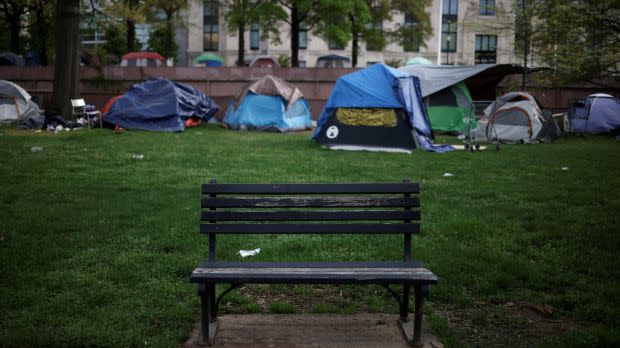The Biden administration is recruiting cities to help solve the US homelessness crisis

The Biden administration is rolling out a new ambitious effort to combat the homelessness crisis in the US. Led by the department of Housing and Urban Development (HUD), the initiative “House America” is designed to help state, local, and tribal governments curb homelessness in their jurisdictions.
The American Rescue Plan Act, the pandemic stimulus bill passed in March of this year, has left states and localities in the US sitting on an unprecedented pile of federal cash. The legislation sets aside $10 billion specifically for homelessness and housing efforts, the most federal spending a US administration has ever dedicated to ending homelessness. (HUD’s annual homelessness spending, by comparison, is about $3 billion.) The plan announced on Sept. 20 sets a coordinated agenda to help them use it effectively.
The plan to reverse a worsening homelessness crisis
After a steady decline for most of the last decade, homelessness has gotten worse in the US, even before the pandemic. The latest estimates from HUD show that 580,466 people were homeless in the US at the beginning of 2020, up 2.2% from the previous year. Among the cities participating in this new initiative are Austin, Los Angeles, and Oakland, places that have all seen numbers of homeless residents increase in recent years alongside housing prices.
“This is an all-hands-on-deck effort to address our homelessness crisis,” said HUD secretary Marcia L. Fudge in a press conference announcing the new program on Sept. 20. The program will try to address the immediate problem by moving 100,000 households, or roughly 20% of the country’s unsheltered population, into supportive housing, and then break the cycle of homelessness by starting construction on new affordable housing in cities by the end of 2022.
The plan sets a clear policy agenda for state, local, and tribal governments to use this money towards “housing first” strategies that prioritize getting people permanent shelter before addressing other health or economic needs. If successful, HUD estimates that this massive investment, combined with other pandemic relief policies, could reduce the number of homeless households by 45%.
How House America creates affordable cities
House America is not new funding, but organizing state, local, and tribal governments to take advantage of $350 billion in federal funds allocated by the American Rescue Plan Act (ARPA). When the legislation was rolled out this past March, even after bailing out hospitals, transit systems, and other public services during the Covid-19 pandemic, it was more money than US localities knew how to spend right away. For homelessness assistance specifically, ARPA also included $5 billion worth of emergency housing vouchers, and $5 billion in HOME grants, a block grant program designed to create affordable housing.
The goal now is to target this spending. “On one hand it’s a rhetorical commitment, but on the other hand, changing the rhetoric is the key to changing our approach to the problem,” says Eric Tars, legal director at the National Homelessness Law Center. “This effort is trying to look at the resources that Congress allocated and say, ‘let’s set some goals, to make sure you’re using it in effective ways, not in ways that are criminalizing homelessness and making the problem worse.”
Philadelphia is planning to expand its shallow rent program, which currently provides rental assistance to 394 tenants in affordable housing projects. In Miami-Dade, Florida, $5 million in ARPA funds will be put to use by their homeless trust to purchase a building to house seniors experiencing homelessness. Austin mayor Steve Adler is thinking even bolder; he says that between federal and private funding for programs, the city is in a position now to make homelessness “rare, infrequent, and recurring” for all residents within three years. The city made headlines earlier this year for its initiative to purchase several hotels to create long-term supportive housing.
Solving homelessness is a long-term challenge
If House America succeeds in creating thousands of units of new housing, it has the potential to bring back social safety net policies not seen in the US in decades, says Tars. In the 1980s, budget cuts to HUD, a restructuring of low-income housing support, and the decline of institutional support for people with mental illness all helped give rise to the modern era of homelessness that policymakers have struggled to solve ever since.
This new initiative marks a big push forward on the part of federal actors, but time will tell whether it is enough to meet the immense need.
The first test is already here. Census data indicates that 3.5 million people across the US could face eviction in the coming months after the federal eviction moratorium ended on Aug. 26, and state and local moratoriums expire across the US. While not all of those at risk will lose their shelter, several states and cities and have seen an uptick in eviction filings, according to data collected by Eviction Lab.
As cases are still making their way through courts, the full impact has yet to be felt, but evictions could pull people into homelessness faster than these programs can get them out.
Sign up for the Quartz Daily Brief, our free daily newsletter with the world’s most important and interesting news.
More stories from Quartz:
